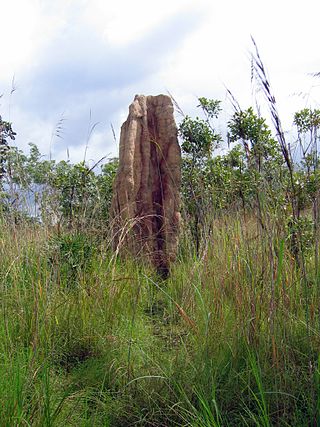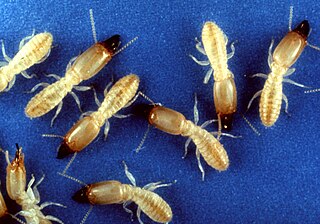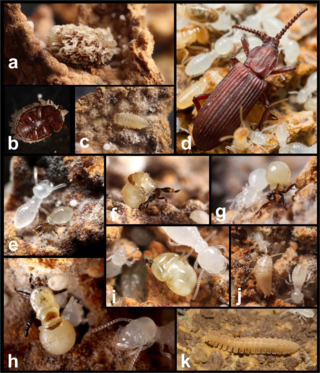
Termites are a group of detritophagous eusocial insects which consume a wide variety of decaying plant material, generally in the form of wood, leaf litter, and soil humus. They are distinguished by their moniliform antennae and the soft-bodied and typically unpigmented worker caste for which they have been commonly termed "white ants"; however, they are not ants, to which they are distantly related. About 2,972 extant species are currently described, 2,105 of which are members of the family Termitidae.

Mound-building termites are a group of termite species that live in mounds which are made of a combination of soil, termite saliva and dung. These termites live in Africa, Australia and South America. The mounds sometimes have a diameter of 30 metres (98 ft). Most of the mounds are in well-drained areas. Termite mounds usually outlive the colonies themselves. If the inner tunnels of the nest are exposed it is usually dead. Sometimes other colonies, of the same or different species, occupy a mound after the original builders' deaths.

Reticulitermes flavipes, the eastern subterranean termite, is the most common termite found in North America. These termites are the most economically important wood destroying insects in the United States and are classified as pests. They feed on cellulose material such as the structural wood in buildings, wooden fixtures, paper, books, and cotton. A mature colony can range from 20,000 workers to as high as 5 million workers and the primary queen of the colony lays 5,000 to 10,000 eggs per year to add to this total.

The Macrotermitinae, the fungus-growing termites, constitute a subfamily of the family Termitidae that is only found within the Old World tropics.

Nasutitermes corniger is a species of arboreal termite that is endemic to the neotropics. It is very closely related to Nasutitermes ephratae. The species has been studied relatively intensively, particularly on Barro Colorado Island, Panama. These studies and others have shown that the termite interacts with many different organisms including a bat that roosts in its nest and various species of ants that cohabit with the termite.

Reticulitermes is a termite genus in the family Rhinotermitidae. They are found in most temperate regions on Earth including much of Asia and the Middle East, Western Europe, and all of North America.

Macrotermes bellicosus is a species of Macrotermes. The queens are the largest of all termites species, measuring about 4.2 inches (110 mm) long when physogastric. The workers average 0.14 in (3.6 mm) in length and soldiers are slightly larger. Bellicosus means "combative" in Latin. The species is a member of a genus indigenous to Africa and South-East Asia.

Hodotermes is a genus of African harvester termites in the Hodotermitidae. They range from Palaearctic North Africa, through the East African savannas to the karroid regions of southern Africa. As with harvester termites in general, they have serrated inner edges to their mandibles, and all castes have functional compound eyes. They forage for grass at night and during the day, and their pigmented workers are often observed outside the nest.
Hypotermes makhamensis is a species of termite in the subfamily Macrotermitinae of the family Termitidae. It lives in dry evergreen forests in tropical south-eastern Asia and builds termite mounds in which it cultivates fungus for use as food.

Amitermes is a genus of termites in the family Termitidae. Species are found in a range of habitats including deserts and rainforests. Characteristics of Amitermes soldiers include a bulbous head, sickle-shaped mandibles with a single tooth on their inner margins and cephalic glands on the front of their heads.

Amitermes meridionalis, commonly known as the magnetic termite or compass termite, is a species of eusocial insect in the family Termitidae. It is endemic to northern Australia and the common names derive from the fact that the wedge-shaped mound is aligned with its main axis running north and south.

Coptotermes lacteus, the milk termite, is a species of termite in the family Rhinotermitidae, native to Australia. These termites are social insects and build a communal nest in the form of a mound. From this, a network of galleries extends through the nearby soil, enabling the workers to forage in the surrounding area without emerging on the surface of the ground.

Coptotermes acinaciformis is a species of subterranean termite in the family Rhinotermitidae native to Australia. Termites are social insects and build a communal nest. In the case of C. acinaciformis, this is either in the root crown of a tree or underground. From this, a network of galleries extends through the nearby soil, enabling the workers to forage in the surrounding area without emerging on the surface of the ground. This termite can cause substantial damage to trees and the wooden parts of buildings.

Macrotermes michaelseni is a species of termite in the family Termitidae, found in sub-Saharan Africa. It is associated with the fungus Termitomyces schimperi.

Macrotermes carbonarius, also known as Kongkiak in Malay, is a large black species of fungus-growing termite in the genus Macrotermes. It is one of the most conspicuous species of Macrotermes found in the Indomalayan tropics, forming large foraging trails in the open that can extend several metres in distance. M. carbonarius is a highly aggressive species with the soldiers possessing large curving mandibles that easily break skin. It is found in Cambodia, Malaysia, Myanmar, Singapore, Thailand and Vietnam.

Hospitalitermes is an Asian–Papuan genus of lichen eating termite in the subfamily Nasutitermitinae. There are 37 species currently listed, of which most are recognized for their extensive surface foraging columns. Due to their conspicuous foraging activities they are commonly known as processionary or marching termites. They often inhabit cavities inside of living trees excavated by other species of termite.
Amitermes floridensis, commonly known as the Florida darkwinged subterranean termite, is a species of eusocial insect in the family Termitidae. It feeds on rotting wood, reached by a network of tunnels. It is endemic to west central Florida and was first described in 1989.

Reticulitermes tibialis, the arid-land subterranean termite, is a species of termite in the family Rhinotermitidae. It is found in the United States, mostly in the western half, occurring in deserts, prairies and other dry locations.

Syntermes is a genus of large Neotropical higher termites within the subfamily Syntermitinae. The genus is found only in South America where members are distributed widely throughout the continent, being found from the tropical rainforests of Colombia to the savannas of Brazil and Northern Argentina.

Odontotermes formosanus is a species of fungus-growing termite in the family Termitidae. It is native to southeastern Asia and was first described from Taiwan. This termite cultivates a symbiotic fungus in a special chamber in the nest. Workers and soldiers gather vegetable detritus which they bring back to the colony, chewing the material to a pulp to make a suitable substrate on which to grow the fungus.

















